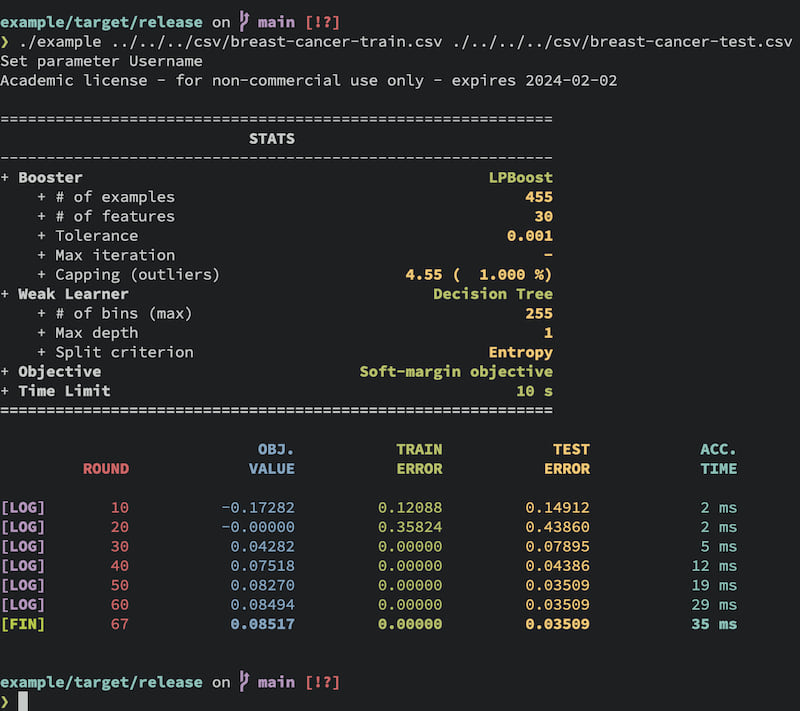10 个版本
| 0.3.4 | 2024 年 8 月 12 日 |
|---|---|
| 0.3.3 | 2023 年 12 月 23 日 |
| 0.3.0 | 2023 年 11 月 4 日 |
| 0.2.3 | 2023 年 8 月 5 日 |
| 0.1.0 | 2023 年 2 月 11 日 |
#30 in 机器学习
每月171次下载
405KB
9K SLoC

MiniBoosts 是一个用于提升算法开发的库。
提升是一种在 提升器 和 弱学习器 之间的重复游戏。
对于游戏的每一轮,
- 提升器选择一个训练样本的分布,
- 然后弱学习器选择一个假设(函数),其相对于分布的准确率略优于随机猜测。
经过足够的轮次后,提升器输出一个在训练样本上表现显著更好的假设。
一些 提升器 需要像这样在 Cargo.toml 中启用 extended 标志
minibosts = { version = "0.3.3", features = ["extended"] }
这些提升算法使用 Gurobi 来计算训练样本的分布。感谢 Gurobi,如果您是学生,您可以免费使用 extended 功能。
提升器 |
特性 标志 |
|---|---|
| AdaBoost 由 Freund 和 Schapire 于 1997 年提出 |
|
| MadaBoost 由 Domingo 和 Watanabe 于 2000 年提出 |
|
| GBM(梯度提升机) 由 Jerome H. Friedman 于 2001 年提出 |
|
| LPBoost 由 Demiriz、Bennett 和 Shawe-Taylor 于 2002 年提出 |
扩展 |
| SmoothBoost 由 Servedio 于 2003 年提出 |
|
| AdaBoostV 由 Rätsch 和 Warmuth 于 2005 年提出 |
|
| TotalBoost 由 Warmuth、Liao 和 Rätsch 于 2006 年提出 |
扩展 |
| SoftBoost 由 Warmuth、Glocer 和 Rätsch 于 2007 年提出 |
扩展 |
| ERLPBoost 由 Warmuth 和 Glocer 以及 Vishwanathan 于 2008 年提出 |
扩展 |
| CERLPBoost(纠正性 ERLPBoost) 由 Shalev-Shwartz 和 Singer 于 2010 年提出 |
扩展 |
| MLPBoost 由 Mitsuboshi、Hatano 和 Takimoto 于 2022 年提出 |
扩展 |
| GraphSepBoost(图分离提升) 由 Alon、Gonen、Hazan 和 Moran 于 2023 年提出 |
如果您发明了一种新的提升算法,您可以通过实现Booster特质来介绍它。有关详细信息,请参阅cargo doc -F extended --open。
目前,没有弱学习器使用Gurobi。因此,您可以在不启用extended标志的情况下使用所有弱学习器。
弱学习器 学习器 |
|---|
| 决策树 |
| 回归树 |
| LPBoost的最坏情况弱学习器 |
| 高斯朴素贝叶斯 |
| 神经网络(实验性) |
为什么是MiniBoosts?
如果您撰写一篇关于提升算法的论文,您需要将您的算法与其他算法进行比较。此时,会出现一些问题。
- 一些提升算法,例如LightGBM或XGBoost,已经实现并免费提供。这些算法在Python3中使用非常容易,但很难与其他算法进行比较,因为它们是用C++内部实现的。在Python3中实现您的算法会使运行时间比较不公平(与C++相比,Python3要慢得多)。然而,用C++实现它非常困难(根据我的经验)。
- 大多数提升算法是为决策树弱学习器设计的,尽管提升协议并不要求如此。
- 没有实现边缘优化提升算法。边缘优化在二元分类中比经验风险最小化是一个更好的目标。
MiniBoosts是一个用于解决上述问题的crate。
此crate提供了以下内容。
- 两个主要特质,分别命名为
Booster和WeakLearner.。- 如果您发明了一种新的提升算法,您只需要实现
Booster. - 如果您发明了一种新的弱学习算法,您只需要实现
WeakLearner.
- 如果您发明了一种新的提升算法,您只需要实现
- 一些著名的提升算法,包括AdaBoost、LPBoost、ERLPBoost等。
- 一些弱学习器,包括决策树、回归树等。
MiniBoosts用于研究
有时,人们想要记录提升过程中的每个步骤。您可以使用Logger结构将日志输出到.csv文件,同时打印出如下状态

有关详细信息,请参阅研究功能部分。
如何使用
将以下内容写入Cargo.toml。
miniboosts = { version = "0.3.3" }
如果您想使用extended功能,启用该标志
miniboosts = { version = "0.3.3", features = ["extended"] }
以下是一个示例代码
use miniboosts::prelude::*;
fn main() {
// Set file name
let file = "/path/to/input/data.csv";
// Read the CSV file
// The column named `class` corresponds to the labels (targets).
let sample = SampleReader::new()
.file(file)
.has_header(true)
.target_feature("class")
.read()
.unwrap();
// Set tolerance parameter as `0.01`.
let tol: f64 = 0.01;
// Initialize Booster
let mut booster = AdaBoost::init(&sample)
.tolerance(tol); // Set the tolerance parameter.
// Construct `DecisionTree` Weak Learner from `DecisionTreeBuilder`.
let weak_learner = DecisionTreeBuilder::new(&sample)
.max_depth(3) // Specify the max depth (default is 2)
.criterion(Criterion::Twoing) // Choose the split rule.
.build(); // Build `DecisionTree`.
// Run the boosting algorithm
// Each booster returns a combined hypothesis.
let f = booster.run(&weak_learner);
// Get the batch prediction for all examples in `data`.
let predictions = f.predict_all(&sample);
// You can predict the `i`th instance.
let i = 0_usize;
let prediction = f.predict(&sample, i);
// You can convert the hypothesis `f` to `String`.
let s = serde_json::to_string(&f);
}
如果您使用提升进行软边缘优化,初始化提升器如下
let n_sample = sample.shape().0; // Get the number of training examples
let nu = n_sample as f64 * 0.2; // Set the upper-bound of the number of outliers.
let lpboost = LPBoost::init(&sample)
.tolerance(tol)
.nu(nu); // Set a capping parameter.
请注意,上限参数必须满足1 <= nu && nu <= n_sample。
研究功能
此crate可以输出每个步骤中此类值的CSV文件。
以下是一个示例
use miniboosts::prelude::*;
use miniboosts::{
Logger,
LoggerBuilder,
SoftMarginObjective,
};
// Define a loss function
fn zero_one_loss<H>(sample: &Sample, f: &H) -> f64
where H: Classifier
{
let n_sample = sample.shape().0 as f64;
let target = sample.target();
f.predict_all(sample)
.into_iter()
.zip(target.into_iter())
.map(|(fx, &y)| if fx != y as i64 { 1.0 } else { 0.0 })
.sum::<f64>()
/ n_sample
}
fn main() {
// Read the training data
let path = "/path/to/train/data.csv";
let train = SampleReader::new()
.file(path)
.has_header(true)
.target_feature("class")
.read()
.unwrap();
// Set some parameters used later.
let n_sample = train.shape().0 as f64;
let nu = 0.01 * n_sample;
// Read the test data
let path = "/path/to/test/data.csv";
let test = SampleReader::new()
.file(path)
.has_header(true)
.target_feature("class")
.read()
.unwrap();
let booster = LPBoost::init(&train)
.tolerance(0.01)
.nu(nu);
let weak_learner = DecisionTreeBuilder::new(&train)
.max_depth(2)
.criterion(Criterion::Entropy)
.build();
// Set the objective function.
// One can use your own function by implementing ObjectiveFunction trait.
let objective = SoftMarginObjective::new(nu);
let mut logger = LoggerBuilder::new()
.booster(booster)
.weak_learner(tree)
.train_sample(&train)
.test_sample(&test)
.objective_function(objective)
.loss_function(zero_one_loss)
.time_limit_as_secs(120) // Terminate after 120 seconds
.print_every(10) // Print log every 10 rounds.
.build();
// Each line of `lpboost.csv` contains the following four information:
// Objective value, Train loss, Test loss, Time per iteration
// The returned value `f` is the combined hypothesis.
let f = logger.run("logfile.csv")
.expect("Failed to logging");
}
其他
- 目前,此crate主要支持用于二元分类的提升算法。
- 一些提升算法使用Gurobi优化器,因此您必须获取许可证才能使用此库。如果您有许可证,可以通过在
Cargo.toml中指定features = ["extended"]来使用这些提升算法(提升器)。如果您在没有Gurobi许可证的情况下尝试使用扩展功能,则编译会失败。 - 可以通过实现
Research特质来记录您的算法。 - 运行
cargo doc -F extended --open以查看更多信息。 GraphSepBoost仅支持其论文中第4.2引理所示的数据聚合规则。
未来工作
-
提升器
-
弱学习器
- 词袋
- TF-IDF
- RBF-Net
-
其他
- 并行化
- LP/QP求解器(此工作允许您在不许可证的情况下使用
extended功能)。
依赖关系
~17-31MB
~451K SLoC